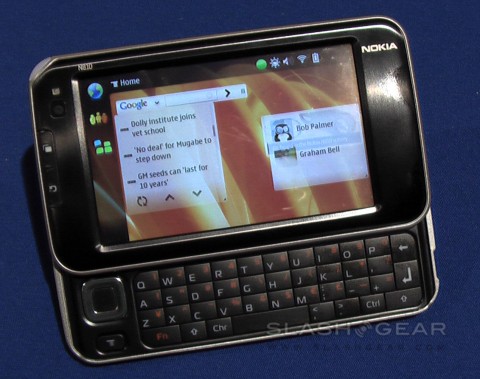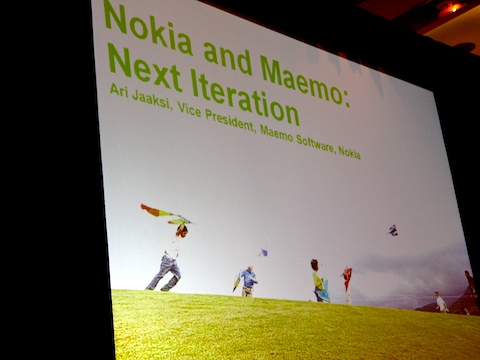
Finally, Apple has introduced a smartphone. The Apple iPhone 3G not only comes with high-speed mobile network access, but it is also possible to download new applications to the device. The capability to enhance the product by installing additional software makes the iPhone a worthy contender in the smartphone market. Advanced features, like A-GPS, Wi-Fi, 3G HSDPA, Bluetooth, and above all, the fantastic touch screen should make the iPhone a popular device for those who are looking for a high-end smartphone.
The Apple iPhone - launched one year ago – looks practically the same as the iPhone 3G. The differences between the first and second iPhone models can be found inside the unit.


Mobile network:
As the name implies, the iPhone can access high-speed 3G mobile networks built on the UMTS/WCDMA technology. The difference between the 2G GSM network and the 3G network is that even an entry-level 3G network provides data transmission rate of up 360 Kbps. If HSDPA technology is available - the iPhone 3G has HSDPA - the maximum data rate is 3.6Mbps.
Audio:
Audio quality during phone calls has considerably improved. Also the loudspeaker has better sound. The iPhone 3G comes with a standard 3.5mm stereo plug so you can use any headphones for listening to music. There's a built-in microphone for phone calls in the headset that's included with the product.
Battery life:
When the 3G mobile network connection is used for Internet access, the battery life is shorter than when Wi-Fi is used. This is peculiar behavior on a smartphone, and may indicate that updates will be on the way. Typically, the most energy-hungry method for Internet access on a smartphone is Wi-Fi, then 3G, and the least power hungry is GSM (GPRS or EDGE).
Software and Services:
With the built-in GPS receiver, maps are available for navigation. Photographers can post their pictures on shared maps on the Internet because GPS can save the exact location where the images were captured.
MobileMe (formerly .Mac) is a significant new service that will help iPhone owners to keep their data safe and in sync with their computers. You sign up to the service and make the initial sync on each Windows PC, Mac, iPod Touch, and iPhone you want to be in sync with other devices. Every time you create a new calendar entry on your PC, or snap a new picture on the iPhone, the information is automatically stored on your account on MobileMe server. Then, it is pushed to each device you have registered for MobileMe service. The same applies to email, notes, and other files. Annual subscription for individual account costs USD 99.
For free sync/backup service that works with iPhone, we recommend Zyb that can sync calendar, contacts and notes.
Corporate email users who have an Microsoft Exchange system at work, can read and send email on the iPhone using the Microsoft Exchange ActiveSync feature.
App Store for application downloads
Apple wants to control all software downloaded into iPhones for security and business reasons. The company has designed App Store, a dedicated online store that offers free and for-sale applications for the iPhone. You don't have to connect the iPhone to a PC for syncing with iTunes, because App Store can be accessed over the air.
The iPhone can't, however, run Java applications that are popular on other smartphones and mobile phones.
Tip: If you are contemplating the bits, bytes and prices of data plans, make full use of the iPhone's Wi-fi capability. If you have access to a Wi-Fi hotspot at home, in the office, at the campus or at the mall, you can use Wi-Fi for all your Internet and email access instead of 3G or 2G mobile network. This way, you can minimize data usage via mobile network and you can subscribe to a smaller data plan.
Apple iPhone 3G Key Features and Specifications:
- 3.5-inch touch-screen. Display resolution is 480x320 pixels. The display can viewed in landscape and horizontal position.
- Multi-touch technology allows control gestures like zoom in/out using two fingers simultaneously.
- Quad-band GSM world phone for networks operating in 850, 900, 1800, 1900 MHz frequency bands. EDGE data connectivity.
- As a dual mode phone, it can connect to 3G UMTS/WCDMA networks operating in 850, 1900, 2100 MHz frequencies, where available. High-speed data download (HSDPA) via 3G network provides maximum rate of 3.6Mbps (HSDPA may not be available even if 3G UMTS is available).
- WLAN for connecting to the Internet via Wi-Fi hotspots.
- A-GPS (Assisted GPS). A GPS receiver that can pick up satellite signals faster if something happens to be blocking clear view to the sky.
- 2-megapixel digital camera. No video recording. Pictures are marked with geographic position obtained from GPS (an activity also known as geotagging).
- Music player can play songs saved in MP3, AAC, Protected AAC, AIFF, Apple Lossless, Audible, and WAV formats.
- Video playback of H.264 (640 by 480 pixels, 30 frames per second), MPEG-4 (640 by 480 pixels, 30 frames per second) movie formats.
- Stereo headphones with microphone. iPhone has 3.5mm stereo plug.
- Text messaging (SMS) and email. No built-in picture messaging (MMS) feature.
- Browser software for viewing Web (HTML) pages.
- Bluetooth 2.0 with EDR feature for high-speed data transfer between compatible Bluetooth devices.
- USB 2.0 interface for hooking up the phone to a Mac or Windows PC via cable. iTunes 7.7 or higher required for data sync.
- 8 GB or 16GB of internal storage space. No removable memory card.
- OS X, a Unix-based operating system software is powering the iPhone.
- The 8GB model is available in black only, but the 16GB model comes in black or white.
- Battery life: talk time up to 10 hours on GSM network and 5 hours on 3G network. Standby time up to 12 days. When used as an iPod MP3 player, audio playback up to 24 hours and video playback up to 7 hours.
- Dimensions (height, width, depth): 4.5 x 2.4 x 0.48 inches / 115 x 62 12 mm. Weight 4.7 oz./133 g
In addition to the smartphone unit, the package includes stereo headset with microphone and a button for answering calls or muting audio, dock connector to USB Cable, USB Power Adapter, user guide, screen polishing cloth, and SIM eject tool.
























